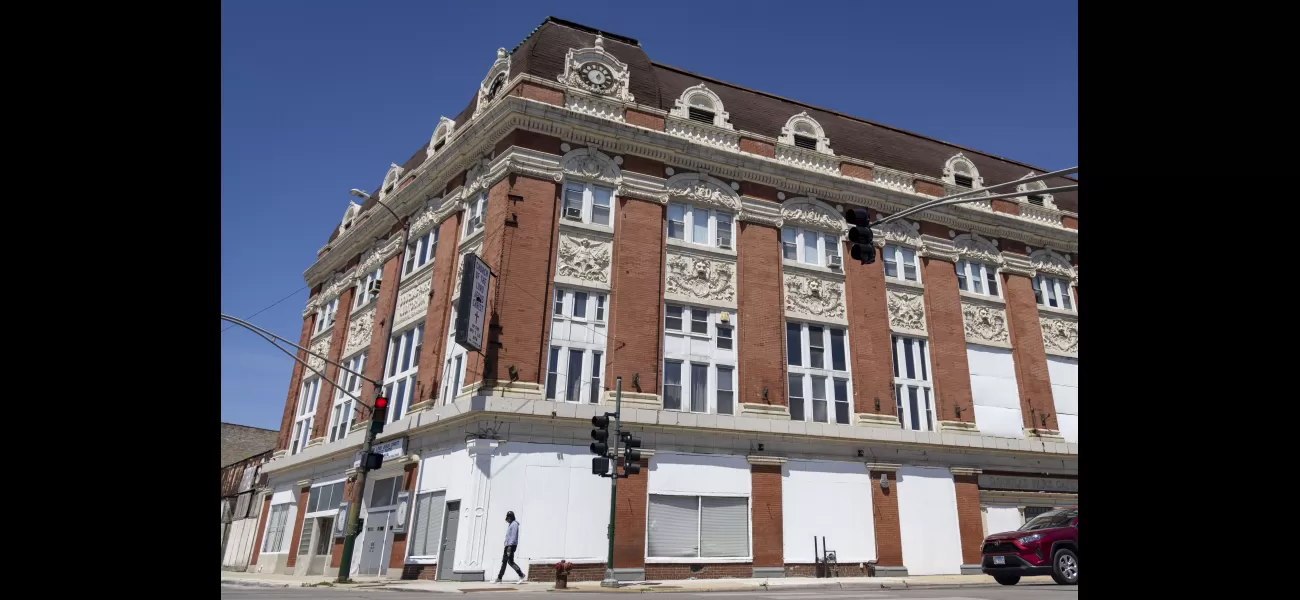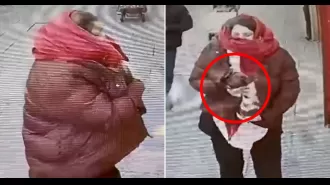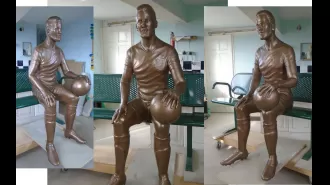The Douglas Park Auditorium was a gathering place for Yiddish theater and radical groups.
The Douglas Park Auditorium was a popular gathering place in the early 1900s, hosting a variety of events such as Yiddish theater and union rallies in a predominantly Jewish community.
June 16th 2024.

If the walls of the Douglas Park Auditorium could speak, they would surely have a lot to say, and most of it would be in Yiddish. This magnificent three-story building, decorated with bas-relief lions and angels, has stood proudly at the corner of Kedzie and Ogden avenues since around 1911. Back then, the neighborhood of North Lawndale was undergoing a transformation as Eastern European immigrants flocked to the area, making it a hub of Jewish culture.
The auditorium's Yiddish theatrical troupe was a beloved feature of the community, with their performances drawing crowds who eagerly listened to the sweet and sentimental cadences of the plays. One of the members of this troupe was Maynard Wishner, who would go on to have a successful legal career, including a role as the executive director of Chicago's Commission on Human Rights. In a 2000 interview with the Chicago Reader, Wishner fondly recalled his time in the troupe, noting that the Douglas Park Theatre was not known for its high artistic aspirations, but rather as a "people's theater."
Wishner reminisced about the plays that were often performed, with their over-the-top and emotional themes, such as "A Mother's Heart," "A Mother's Tears," and "A Mother's Heart and Tears." But the Yiddish theater was just one aspect of the bustling community life that revolved around the Douglas Park auditorium during the first half of the 20th century. Eventually, the neighborhood's demographics changed, and the building was repurposed as a church for the African American residents.
In its early years, the auditorium was a popular venue for various events, including alumnae reunions, fundraisers for summer camps, and union dinners. The building was the brainchild of architect Alexander Levy, who was born to immigrant Jewish parents in Missouri. After obtaining a degree in architecture from the University of Illinois, Levy also taught mechanical drawing at Hyde Park High School while taking on design projects on the side. One notable event he designed was a benefit bazaar for the Orthodox Home for Aged Jews, where he recreated the bustling streets of Jerusalem's Old City on the 12th floor of a Loop building.
Levy eventually left his teaching job to focus on architecture full time. He became known for his dramatic and ornate designs, as seen in the Douglas Park Auditorium's intricate lions and angels. However, he also created more classical structures, such as the neo-classical Ohave Sholom Mariampol synagogue, which later became a Greek Orthodox Church.
Levy's unique and adaptable style caught the attention of Samuel Polakow, who had purchased the property at Ogden and Kedzie for $20,000 and was in need of an architect to create a state-of-the-art auditorium. Polakow's instructions were simple - he wanted the Douglas Park Auditorium to be one of the finest entertainment buildings in all of Chicago.
Levy's designs included various profit-generating areas within the building, such as six ground-level stores, a dining room, a large ballroom, and smaller ballroom on the second and third floors, respectively, and six lodge halls. However, Polakow sold the building in 1912, just a year after he sued two of his tenants for violating a lease clause that prohibited the sale of liquor on Sundays, which could potentially disturb the building's tenants and the surrounding neighborhood.
In the same year, the auditorium was scheduled to host speeches by the Slatterys, a former priest and nun, who were members of an anti-Catholic organization called the Guardians of Liberty. The police were concerned about the potential for violence from nearby residents, and 200 officers were assigned to riot duty. However, the event never took place, as the hall's manager, Isadore Gillman, canceled the lease at the last minute, avoiding any potential chaos.
The Douglas Park Auditorium continued to be a popular destination for various events, and in 1921, it was the target of a cunning promoter who claimed that the famous Russian ballerina Anna Pavlova would be performing there for a benefit show. However, it was later revealed that the dancer was not actually the acclaimed artist, leading to a humorous clarification by the Chicago Tribune. Despite the occasional drama, the Douglas Park Auditorium remained a cherished part of the community, catering to the diverse interests and needs of its residents for decades to come.
If the Douglas Park Auditorium walls could talk, they would have plenty to say about the vibrant and diverse community that once called North Lawndale home. This three-story structure, adorned with bas-relief lions and angels, has stood at the intersection of Kedzie and Ogden avenues since around 1911. At the time, this neighborhood was being transformed by Eastern European immigrants, who were turning it into a thriving Jewish community.
Inside the auditorium, the sounds of Yiddish could be heard as the local Jewish population flocked to see the popular theatrical troupe. One of the child members of this troupe, Maynard Wishner, would go on to have a successful career in law. He fondly recalled the Douglas Park Theatre in a 2000 interview, saying it was a "people's theater" that didn't aim for high art. He even joked about the typically schmaltzy plays they would put on, such as "A Mother's Heart", "A Mother's Tears", and "A Mother's Heart and Tears".
But the Yiddish theater was just one part of the lively community life that took place at the Douglas Park auditorium in the first half of the 20th century. It was a popular venue for a variety of events, from alumnae reunions to fundraisers for summer camps and union dinners. The building itself was designed by Alexander Levy, a Jewish architect who had a knack for incorporating dramatic elements into his work. This was evident in the ornate lions and angels that adorned the facade of the Douglas Park Auditorium.
But Levy's talents were not limited to theatrical buildings. He also designed neo-classical synagogues, such as the Ohave Sholom Mariampol, which would later become a Greek Orthodox Church. It was Levy's flexible aesthetics that caught the attention of Samuel Polakow, who commissioned him to design the auditorium on the property he had purchased for $20,000 at the corner of Ogden and Kedzie. Polakow's only request was for the building to be "one of the finest equipped amusement buildings in Chicago".
The Douglas Park Auditorium was a bustling hub of activity, with six stores on the ground level, a dining room and large ballroom on the second floor, and a smaller ballroom and six lodge halls on the third floor. However, in 1912, Polakow sold the building after suing two of his tenants for violating an ordinance prohibiting the sale of liquor on Sundays. The outcome of the dispute is unknown, but it was just one event in a year full of noteworthy incidents.
In March 1912, the auditorium was set to host speeches by the leaders of the Guardians of Liberty, a fiercely anti-Catholic organization. The police were on high alert, anticipating riots due to the nearby presence of several church spires. However, the event never took place as the manager of the hall, Isadore Gillman, cancelled the lease for the speakers at the last minute.
The Douglas Park Auditorium was not immune to unscrupulous individuals trying to take advantage of its popularity. In 1921, a promoter falsely claimed that the famous Russian ballerina Anna Pavlova would be giving a benefit performance at the auditorium. This caused confusion and prompted the Russian consul general to clarify that the dancer was not, in fact, the real Pavlova.
Today, the Douglas Park Auditorium stands as a reminder of the vibrant and diverse community that once thrived in North Lawndale. Though its use may have changed over the years, the memories and stories it holds are a testament to the rich history of the area.
The auditorium's Yiddish theatrical troupe was a beloved feature of the community, with their performances drawing crowds who eagerly listened to the sweet and sentimental cadences of the plays. One of the members of this troupe was Maynard Wishner, who would go on to have a successful legal career, including a role as the executive director of Chicago's Commission on Human Rights. In a 2000 interview with the Chicago Reader, Wishner fondly recalled his time in the troupe, noting that the Douglas Park Theatre was not known for its high artistic aspirations, but rather as a "people's theater."
Wishner reminisced about the plays that were often performed, with their over-the-top and emotional themes, such as "A Mother's Heart," "A Mother's Tears," and "A Mother's Heart and Tears." But the Yiddish theater was just one aspect of the bustling community life that revolved around the Douglas Park auditorium during the first half of the 20th century. Eventually, the neighborhood's demographics changed, and the building was repurposed as a church for the African American residents.
In its early years, the auditorium was a popular venue for various events, including alumnae reunions, fundraisers for summer camps, and union dinners. The building was the brainchild of architect Alexander Levy, who was born to immigrant Jewish parents in Missouri. After obtaining a degree in architecture from the University of Illinois, Levy also taught mechanical drawing at Hyde Park High School while taking on design projects on the side. One notable event he designed was a benefit bazaar for the Orthodox Home for Aged Jews, where he recreated the bustling streets of Jerusalem's Old City on the 12th floor of a Loop building.
Levy eventually left his teaching job to focus on architecture full time. He became known for his dramatic and ornate designs, as seen in the Douglas Park Auditorium's intricate lions and angels. However, he also created more classical structures, such as the neo-classical Ohave Sholom Mariampol synagogue, which later became a Greek Orthodox Church.
Levy's unique and adaptable style caught the attention of Samuel Polakow, who had purchased the property at Ogden and Kedzie for $20,000 and was in need of an architect to create a state-of-the-art auditorium. Polakow's instructions were simple - he wanted the Douglas Park Auditorium to be one of the finest entertainment buildings in all of Chicago.
Levy's designs included various profit-generating areas within the building, such as six ground-level stores, a dining room, a large ballroom, and smaller ballroom on the second and third floors, respectively, and six lodge halls. However, Polakow sold the building in 1912, just a year after he sued two of his tenants for violating a lease clause that prohibited the sale of liquor on Sundays, which could potentially disturb the building's tenants and the surrounding neighborhood.
In the same year, the auditorium was scheduled to host speeches by the Slatterys, a former priest and nun, who were members of an anti-Catholic organization called the Guardians of Liberty. The police were concerned about the potential for violence from nearby residents, and 200 officers were assigned to riot duty. However, the event never took place, as the hall's manager, Isadore Gillman, canceled the lease at the last minute, avoiding any potential chaos.
The Douglas Park Auditorium continued to be a popular destination for various events, and in 1921, it was the target of a cunning promoter who claimed that the famous Russian ballerina Anna Pavlova would be performing there for a benefit show. However, it was later revealed that the dancer was not actually the acclaimed artist, leading to a humorous clarification by the Chicago Tribune. Despite the occasional drama, the Douglas Park Auditorium remained a cherished part of the community, catering to the diverse interests and needs of its residents for decades to come.
If the Douglas Park Auditorium walls could talk, they would have plenty to say about the vibrant and diverse community that once called North Lawndale home. This three-story structure, adorned with bas-relief lions and angels, has stood at the intersection of Kedzie and Ogden avenues since around 1911. At the time, this neighborhood was being transformed by Eastern European immigrants, who were turning it into a thriving Jewish community.
Inside the auditorium, the sounds of Yiddish could be heard as the local Jewish population flocked to see the popular theatrical troupe. One of the child members of this troupe, Maynard Wishner, would go on to have a successful career in law. He fondly recalled the Douglas Park Theatre in a 2000 interview, saying it was a "people's theater" that didn't aim for high art. He even joked about the typically schmaltzy plays they would put on, such as "A Mother's Heart", "A Mother's Tears", and "A Mother's Heart and Tears".
But the Yiddish theater was just one part of the lively community life that took place at the Douglas Park auditorium in the first half of the 20th century. It was a popular venue for a variety of events, from alumnae reunions to fundraisers for summer camps and union dinners. The building itself was designed by Alexander Levy, a Jewish architect who had a knack for incorporating dramatic elements into his work. This was evident in the ornate lions and angels that adorned the facade of the Douglas Park Auditorium.
But Levy's talents were not limited to theatrical buildings. He also designed neo-classical synagogues, such as the Ohave Sholom Mariampol, which would later become a Greek Orthodox Church. It was Levy's flexible aesthetics that caught the attention of Samuel Polakow, who commissioned him to design the auditorium on the property he had purchased for $20,000 at the corner of Ogden and Kedzie. Polakow's only request was for the building to be "one of the finest equipped amusement buildings in Chicago".
The Douglas Park Auditorium was a bustling hub of activity, with six stores on the ground level, a dining room and large ballroom on the second floor, and a smaller ballroom and six lodge halls on the third floor. However, in 1912, Polakow sold the building after suing two of his tenants for violating an ordinance prohibiting the sale of liquor on Sundays. The outcome of the dispute is unknown, but it was just one event in a year full of noteworthy incidents.
In March 1912, the auditorium was set to host speeches by the leaders of the Guardians of Liberty, a fiercely anti-Catholic organization. The police were on high alert, anticipating riots due to the nearby presence of several church spires. However, the event never took place as the manager of the hall, Isadore Gillman, cancelled the lease for the speakers at the last minute.
The Douglas Park Auditorium was not immune to unscrupulous individuals trying to take advantage of its popularity. In 1921, a promoter falsely claimed that the famous Russian ballerina Anna Pavlova would be giving a benefit performance at the auditorium. This caused confusion and prompted the Russian consul general to clarify that the dancer was not, in fact, the real Pavlova.
Today, the Douglas Park Auditorium stands as a reminder of the vibrant and diverse community that once thrived in North Lawndale. Though its use may have changed over the years, the memories and stories it holds are a testament to the rich history of the area.
[This article has been trending online recently and has been generated with AI. Your feed is customized.]
[Generative AI is experimental.]
0
0
Submit Comment





